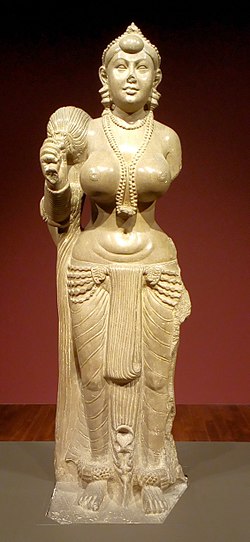
Back दीदारगंज यक्षी Bihari दीदारगंज यक्षी Hindi ディーダルガンシ・ヤクシー Japanese ದಿದರ್ಗಂಜ್ ಯಕ್ಷಿ Kannada ഡിഡാർഗഞ്ച് യക്ഷി Malayalam Якшини из Дидарганджа Russian Didarganj Yakshi Serbo-Croatian දිදාර්ගන්ජ් යක්ෂි Singhalese தீதார்கஞ்ச் யட்சினி Tamil Якшині з Дідарганджу Ukrainian
| Didarganj Yakshi | |
|---|---|
 Didarganj Yakshi (Chauri Bearer) with fly-whisk (chauri) is held in the right hand whereas the left hand is broken, in Bihar Museum. | |
| Material | Polished sandstone |
| Height | 5 feet 2 inches (1.57 m) |
| Period/culture | 3rd century BCE or 1st/2nd century CE |
| Discovered | 25°34'18"N 85°15'45"E |
| Place | Didarganj, Patna, Bihar, India |
| Present location | Bihar Museum, India |
The Didarganj Yakshi (or Didarganj Chauri Bearer; Hindi: दीदारगंज यक्षी) is one of the finest examples of very early Indian stone statues. It used to be dated to the 3rd century BCE, as it has the fine Mauryan polish associated with Mauryan art, but this is also found on later sculptures and it is now usually dated to approximately the 2nd century CE, based on the analysis of shape and ornamentation,[1][2] or the 1st century CE.[3] The treatment of the forelock in particular is said to be characteristically Kushan.[4]
The sculpture is now in the Bihar Museum in Patna, Bihar, India,[5] close to where it was found in 1917.[6][7] Patna, as Pataliputra, was also the Mauryan capital.
The statue is 5 feet 2 inches (1.57 m) tall on a pedestal of 1 foot 7.5 inches (49.5 cm) made of Chunar sandstone highly finished to a mirror-like polish.[8] The life-size standing image is a tall, well-proportioned, free-standing sculpture made of sandstone with the well-polished surface associated with Mauryan polish, although this persisted for some time after the empire fell. The fly-whisk (chauri) is held in the right hand whereas the left hand is broken. The lower garment creates a somewhat transparent effect. Like many of the earliest large sculptures in Indian art, it represents a minor spiritual figure or deity, a yakshi, rather than one of the major deities.[9]
- ^ Singh, Upinder (2008). A History of Ancient and Early Medieval India: From the Stone Age to the 12th Century. Pearson Education India. ISBN 978-81-317-1677-9.
- ^ Mandal, Dhaneshwar (2003). Ayodhya, Archaeology After Demolition: A Critique of the "new" and "fresh" Discoveries. Orient Blackswan. p. 46. ISBN 978-81-250-2344-9.
- ^ Harle 1994, p. 31; Rowland 1967, p. 100
- ^ Pereira, Jose (2001). Monolithic Jinas. Motilal Banarsidass. p. 11. ISBN 9788120823976.
- ^ Sinha, Chinki (13 October 2017). "This museum in Bihar houses a 2300-year-old sculpture carved out of a single stone". India Today.
- ^ Poduval, Jayaram (10 January 2022). "Didarganj to Kalliyankadu, the Yakshi story". Opinions. New Indian Express.
- ^ Hashmi, Sohail (23 July 2017). "Didarganj Yakshi: Conflict between myth and history". DNA India.
- ^ "Didarganj Yakshi". India Archeology. 7 March 2009. Retrieved 30 August 2011.
- ^ Michell 1977, p. 33.
© MMXXIII Rich X Search. We shall prevail. All rights reserved. Rich X Search
